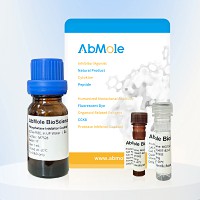All AbMole products are for research use only, cannot be used for human consumption.

Recombinant Human FGF-basic (145aa, E. coli) also known as FGF-2, is a pleiotropic cytokine and one of the prototypic members of the heparin-binding FGF family. In vivo, FGF-basic is produced by a variety of cells, including cardiomycotes, fibroblasts, and vascular cells. FGF-basic regulates a variety of processes including cell proliferation, differentiation, survival, adhesion, motility, apoptosis, limb formation and wound healing. FGF-basic can be tumorigenic due to its role in angiogenesis and blood vessel remodeling. The angiogenic effects of FGF-basic can produce beneficial cardioprotection during acute heart injury.
Measured by the cell proliferation assay using 3T3 cells, the ED50 is < 0.25 ng/ml, corresponding to a specific activity of > 4.0 × 106 units/mg.
Accession: P09038
Apparent Molecular Weight: ~16.4 kDa, reducing conditions.
Lyophilized after extensive dialysis against PBS.

Adv Biotechnol (Singap). 2025 Mar 11; .
Simplifying the protocol for low-pollution-risk, efficient mouse myoblast isolation and differentiation
Recombinant Human FGF-basic (145aa, E. coli) purchased from AbMole

Patent. CN119144548B 2025-03-11.
Patent. CN119144548B
Recombinant Human FGF-basic (145aa, E. coli) purchased from AbMole

Patent. CN119144548A 2024 Dec 17.
Patent. CN119144548A
Recombinant Human FGF-basic (145aa, E. coli) purchased from AbMole
| Form | Lyophilized powder |
| Solubility (25°C) | Reconstitute the lyophilized powder in ddH2O or PBS to 100 μg/ml |
| Storage | Stable for up to 6 months at ≤ -20°C. Upon reconstitution, the product should be stable for up to 1 week at 4°C or up to 3 months at -20°C. |
[5] D Ledoux, et al. Prog Growth Factor Res. Interactions of FGFs with target cells
| Related Cytokines and Growth Factors Products |
|---|
| Recombinant Human GDF-15 Protein (HEK293 N-hFc)
Growth-differentiation factor 15 (GDF15), also known as MIC-1, is a secreted member of the transforming growth factor (TGF)-β superfamily. GDF-15 has a role in regulating inflammatory and apoptotic pathways in injured tissues and during disease processes. GDF-15 overexpression arising from an expanded erythroid compartment contributes to iron overload in thalassemia syndromes by inhibiting hepcidin expression. |
| Recombinant Human FGFR1 Protein (HEK293, C-His)
FGFR1, also known as CD331, is a full-length representative protein consists of an extracellular region, composed of three immunoglobulin-like domains, a single hydrophobic membrane-spanning segment and a cytoplasmic tyrosine kinase domain. |
| Recombinant Human FGFR2 Protein (HEK293, C-His)
FGFR2, also known as CD332, acts as cell-surface receptor for fibroblast growth factors and plays an essential role in the regulation of cell proliferation, differentiation, migration and apoptosis, and in the regulation of embryonic development. FGFR2 plays an essential role in the regulation of osteoblast differentiation, proliferation and apoptosis, and is required for normal skeleton development. It also promotes cell proliferation in keratinocytes and imature osteoblasts, but promotes apoptosis in differentiated osteoblasts. |
| Recombinant Mouse BMP-4 Protein (E. coli, C-His)
Bone Morphogenetic Protein-4 (BMP-4) is a critical signaling molecule required for the early differentiation of the embryo and establishing of a dorsal-ventral axis. BMP-4 is secreted from the dorsal portion of the notochord, and it acts in concert with sonic hedgehog to establish a dorsal-ventral axis for the differentiation of later structures. |
| Recombinant Human Coagulation Factor X (HEK293, C-Fc)
Coagulation factor X, belongs to the peptidase S1 family. Coagulation factor X is initially synthesized in the liver. Coagulation factor X is a vitamin K-dependent glycoprotein that converts prothrombin to thrombin in the presence of factor Va, calcium and phospholipid during blood clotting. |
All AbMole products are for research use only, cannot be used for human consumption or veterinary use. We do not provide products or services to individuals. Please comply with the intended use and do not use AbMole products for any other purpose.


Products are for research use only. Not for human use. We do not sell to patients.
© Copyright 2010-2024 AbMole BioScience. All Rights Reserved.
